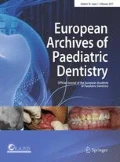Abstract
AIM: This was to investigate caries experience and patterns in a sample of 5-year-old children attending nursery schools in the Veneto Region (Italy). STUDY DESIGN: Cross sectional study. METHODS: The study was carried out between September 2005 and May 2006 with 348 randomly selected 5-year-old children. Two calibrated dentists using an artificial light, a plane dental mirror and a dental probe performed clinical dental examination. World Health Organisation (WHO) diagnostic criteria for dental caries: dmft, dmfs and SiC indexes were used to measure the severity of the disease. STATISTICS: dmfs scores were analysed either as a continuous continuous (calculating means and standard deviations) or as a categorical variable (providing proportions). Pearson’s chi square test for comparison between groups and Wilcoxon signed-rank test for distribution of dmfs scores between pairs of contiguous molars were used. RESULTS: The most commonly affected teeth were primary molars, (78% of the overall sample), especially in the mandible. The surfaces of molars most often affected were the occlusal (52%). Proximal surfaces were affected more in first than in second primary molars. Dental caries occurred most often in the maxilla. The frequency of caries in anterior teeth was low (12%). CONCLUSIONS: Caries experience in the primary dentition showed a symmetrical distribution localized on primary molars, most often in their occlusal surface. Caries in anterior teeth was uncommon.
Similar content being viewed by others
References
Douglass JM, Wei Y, Zhang BX, Tinanoff N. Caries prevalence and patterns in 3–6 year old Beijing children. Community Dent Oral Epidemiol 1995; 23:340–343.
Douglass JM, Tinanoff N, Tang JMW, Altman DS. Dental caries patterns and oral health behaviors in Arizona infants and toddlers. Community Dent Oral Epidemiol 2001; 29:14–22.
Dunning JM. Epidemiology: Dental caries. Principles of Dental Public Health. 4th edn. Cambridge, 1986
Elfrink MEC, Veerkamp JSJ, Kalsbeek H: Caries pattern in primary molars in Dutch 5-year-old children. Eur Arch Paediatr Dent 2006; 7:236–240.
Ferro R, Besostri A, Meneghetti B. Dental caries experience in preschool children in Veneto region (Italy). Community Dent Health. 2006;23:91–4.
Ferro R, Besostri A, Meneghetti B, Stellini E. Prevalence and severity of dental caries in 5- and 12-year old children in the Veneto Region (Italy). Community Dent Health. 2007;24:88–92.
Ferro R, Besostri A, Olivieri A, Stellini E, Mazzoleni S. Preschoolers’ dental caries experience and its trend over 20 years in a North-east Italian Health District. Eur J Paedr Dent 2007 Dec; 8(4): 199–204.
Gizani S, Vinckier F, Declerck D. Caries pattern and oral health habits in 2- to 6-year-old children exhibiting differing levels of caries. Clin Oral Invest 1999; 3:35–40.
Hallett KB, O’Rourke PK. Pattern and severity of early childhood caries. Community Dent Oral Epidemiol 2006; 34:25–35.
Hugoson A, Koch G, Helkimo AN, Lundin SA. Caries prevalence and distribution in individuals aged 3–20 years in Jonkoping, Sweden, over a 30-year period (1973–2003). Int J Paediatr Dent 2008; 18(1): 18–26.
Hujoel PP, Lamont RJ, DeRouen TA, Davis S, Leroux BG. Within-subject coronal caries distribution patterns: an evaluation of randomness with respect to midline. J Dent Res 1994;73(9): 1575–1580.
Johnsen DC, Schubot M, Bhat M, Jones PK. Caries pattern identification in the primary dentition: a comparison of clinician assignment and clinical analysis groupings. Pediatr Dent 1993; 15:113–115.
Li Y, Wang W. Predicting caries in permanent teeth from caries in primary teeth:an eight-year cohort study. J Dent Res 2002 (81)8:561–566.
O’Sullivan DM, Tinanoff N. Maxillary anterior caries associated with increased caries risk in other primary teeth. J Dent Res 1993; 72:1577–1580.
Petersen PE, Bourgeois D, Bratthall D, Ogawa H. Oral health information systems — towards measuring progress in oral health promotion and disease prevention, 2005. Bulletin of the World Health Organisation 83(9):686-693.
Pitts NB, Chestnutt IG, Evans et al. The dentinal caries experience of children in the United Kingdom, 2003. Brit Dent J 2006; 200:313–320.
Pitts NB, Evans DJ, Nugent ZJ. The dental caries experience of 5-year-old children in the United Kingdom. Surveys co-ordinated by the British Association for the Study of Community Dentistry in 1997/98. Community Dent Health 1999; 16:50–56
Pitts NB, Boyles J, Nugent ZJ, Thomas N, Pine CM. The dental caries experience of 5-year-old children in Great Britain (2005/6). Surveys co-ordinated by the British Association for the study of community dentistry. Community Dent Health. 2007;24:59–63
Psoter WJ, Zhang H, Pendrys DG, Morse DE, Mayne S. Classification of dental caries patterns in the primary dentition: a multidimensional scaling analysis. Community Dent Oral Epidemiol 2003; 31:231–238.
Saravanan S, Madivanan I, Subashini B, Felix JW. Prevalence pattern of dental caries in the primary dentition among schoolchildren. Indian J Dent Res 2005; 16:140–146.
Skeie MS, Espelid I, Skaare AB, Gimmestad A. Caries patterns in an urban preschool population in Norway. Eur J Paediatr Dent 2005;1:16–22.
Skeie MS, Raadal M, Strand GV, Espelid I. The relationship between caries in the primary dentition at 5 years of age and permanent dentition at 10 years of age-a longitudinal study. Int J Paediatr Dent 2006; 16:152–160.
U.S.A. Department of Health and Human Services: A report of the Surgeon General (2000). Rockville, MD. Department of Health and Human Services, US Public Health Service.
Vanobbergen J, Lesaffre E, Garcia-Zattera MJ. Caries patterns in primary dentition in 3-,5- and 7-year-old children: spatial correlation and preventive consequences. Caries Res 2007;41:16–25.
World Medical Association: World Medical Association Declaration of Helsinki. Ethical principles for medical research involving human subjects. Bull World Health Organ 2001; 79(4): 373–4 Epub 2003 Jul 2.
WHO: Oral Health Surveys 4th ed., 1997
Wyne AH. Caries prevalence, severity and pattern in preschool children. J Contemp Dent Pract 2008 (9)3:24–31.
Author information
Authors and Affiliations
Corresponding author
Rights and permissions
About this article
Cite this article
Ferro, R., Besostri, A. & Olivieri, A. Caries prevalence and tooth surface distribution in a group of 5-year-old Italian children. Eur Arch Paediatr Dent 10, 33–37 (2009). https://doi.org/10.1007/BF03262665
Published:
Issue Date:
DOI: https://doi.org/10.1007/BF03262665




